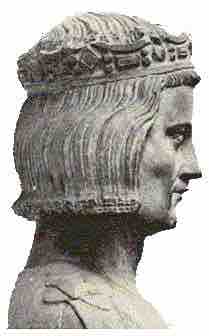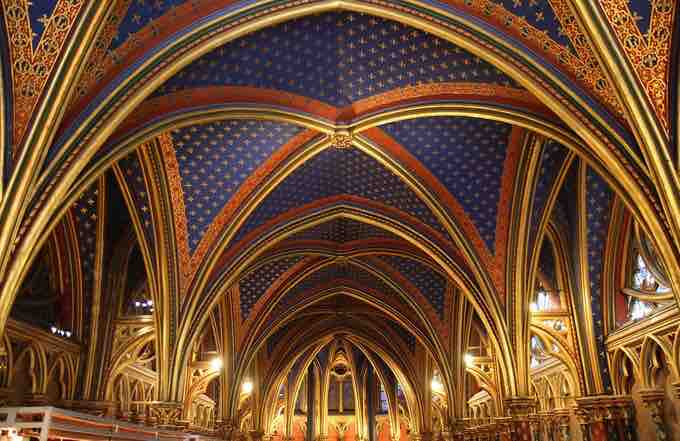Louis IX ruled during the so-called "golden century of Saint Louis," when the Kingdom of France was at its height of power in Europe, both politically and economically. The king of France was regarded as a primus inter pares among the kings and rulers of the continent. He commanded the largest army, and ruled the largest and most wealthy kingdom of Europe, which was the European center of arts and intellectual thought (La Sorbonne) at the time. The prestige and respect for King Louis IX resulted more from his benevolent personality than from his military domination. For his contemporaries, he was the quintessential example of the Christian prince, and embodied the whole of Christendom in his person. The King was later recognized as a saint by the Catholic Church.

Bust of St. Louis, ca. 1300 from the church of Mainneville, Eure, France
Louis IX, or Saint Louis, was a revered leader and strong patron of the arts during the Gothic period.
The style of Louis' court radiated throughout Europe through the purchase of art objects from Parisian masters for export and by the marriage of the King's daughters and female relatives to foreign husbands. Louis' personal chapel, La Sainte-Chapelle in Paris, was copied more than once by his descendants elsewhere.

Sainte-Chapelle, ceiling of the lower chapel
Saint Louis' Sainte-Chapelle epitomizes the Rayonnant Gothic style as was King Louis IX's personal chapel.
La Sainte-Chapelle (The Holy Chapel) is one of the only surviving buildings of the Capetian royal palace on the Île de la Cité in the heart of Paris, France. It was commissioned by King Louis IX of France to house his collection of relics of the passion, including the Crown of Thorns—one of the most important relics in medieval Christendom. Begun some time after 1239 and consecrated on April 26, 1248, the Sainte-Chapelle is considered among the highest achievements of the Rayonnant period of Gothic architecture. Although damaged during the French revolution and heavily restored in the 19th century, it retains one of the most extensive in-situ collections (collections that are still in their original positions) of 13th century stained glass anywhere in the world. The glass depicts stories from the Old Testament and focuses heavily on the depictions of biblical kings, both good and bad. Scholars believe the inclusion of "bad" kings, along with the good, were meant as a lesson for the royal viewer to learn from both good and bad examples of rulership.
La Sainte-Chapelle is a prime example of the phase of Gothic architectural style called "Rayonnant Gothic," also known as Court Style, and is marked by its sense of weightlessness and strong vertical emphasis. Rayonnant structures tend to be smaller than the High Gothic Cathedrals that came before them. La Sainte-Chapelle stands squarely upon a lower chapel, which served as parish church for all the inhabitants of the palace, which was the seat of government. However, the chapel proper was a private royal chapel and scholars have noted how the structure almost looks like metalwork, as if the chapel itself is a reliquary.